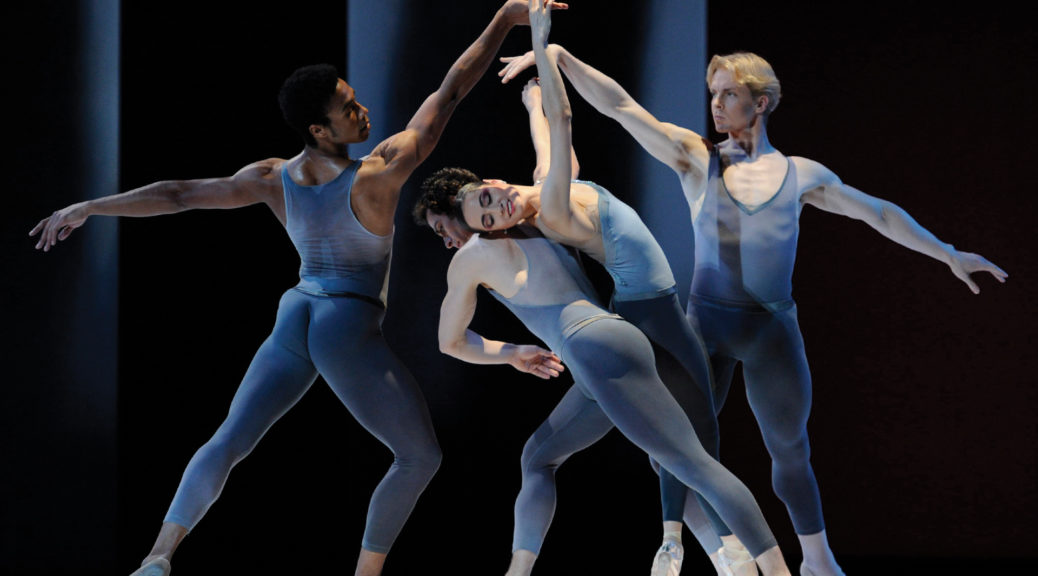
Moving Story Ballet; Others, Not So Moving
Story ballets are an endangered species these days, certainly nothing compared to the mid-20th century when Agnes deMille and others reigned. New ballets coming down the pike today emphasize ever sharper athleticism and technique, with acting and mime usually stashed away in the closet or confined to oldie revivals.
The English choreographer Cathy Marston still dares to be raconteur, and her reprise of “Snowblind” (2018) was the vibrant centerpiece of the S.F. Ballet’s otherwise uneven Program Three opener. It features a love triangle, not the most apt theme for Valentine’s Day. Taken from Edith Wharton’s novel “Ethan Frome,” “Snowblind” spotlights the vibrant Ethan saddled with an elderly sickly wife Zeena and turning his attention and passion to the lovely young woman Mattie. Patrick Kinmonth’s two-story set has the couple wearing out the stairway accessing the sickbed upstairs, resulting in an aghast Zeena viewing the shenanigans of the others downstairs.
Pas de deux pairings with each woman reveal their contrasting personae. Zeena’s imposing the symbolic apron on Matie establishes hierarchy. A symbolic corps of darting gray figures represents the adverse elements, or doom, or a sort of Greek chorus; ambiguities are Marston’s hallmark. In her most inspired creation, she has the trio join all their arms in a turning, twisting linkage in which Zeena battles to stand in the forefront, with Matie pushed behind. This night the theatrical cast featured the tall Ulrik Birkkjaer in the title role, with a fetching Mathilde Froustey as Matie the hired girl, and Jennifer Stahl, who’s not old at all, as the ever more abandoned wife in quirky, erratic moves. Result: Somewhere between a stalemate and a Camus-like “Dead End.” A grabbag of musical choices served “Snowblind” surprisingly well.
Casts change of course nightly. This effective trio of personae showed the international emphasis among SFB principals, with Birkkjaer coming from Denmark and Froustey from France. In fact, the roster of principals features only four born in America, with the other 15 hailing from eleven different countries.
Weighing down the program is the very dated Harald Lander “Etudes” of 1948. This workout theme has been aired by many others, but surely once in a lifetime is plenty for seeing any ballet based on a ballet class’ crescendo moves. It’s an hour-long ordeal showing every step and movement of classical ballet—flawlessly executed, yes, but stodgy, academic, tedious. What’s worse, it wears the concrete shoes of a vulgar-flashy orchestration of the gruesome Czerny piano exercises perhaps imposed on you as a kid.
Its purpose? To show off a virtuoso company with immense depth of talent. Point made. Now—move on!!
On a happier note was “The Fifth Season” (2006) by Company Director Helgi Tomasson—once the traditionalist, now an engaging modernist. Sofiane Sylve, she of the finely sculpted frame, worked through the Tango solo, then gave way to the ardent duo of Yuan Yuan Tan—surely the tiniest in the company, and among the best—with the muscular he-man Tiit Helimets. With him the infinitely pliable veteran ended up in a pretzel shape, more or less on his lap, which was one of several adroit Tomasson movement innovations here.
The thoroughly professional pair of Dores André and Vitor Luiz added several solos in this ingratiating modernism, backed by Sandra Woodall’s abstract-art backdrops.
Karl Jenkins’ music here was among the most eclectic ever: waltz, tango, bluesy finale. It’s as if he had studied with Paul Hindemith and adopted Gebrauchsmusik. It worked better than expected, unfurling under the versatile baton of Martin West.
San Francisco Ballet, Program 3, opened Feb. 14, Opera House, S.F. Two hours three-quarters. For SFB info: (415) 865-2000 or go online.